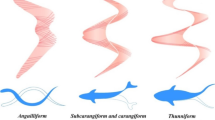Abstract
Currently, the integrated biomechanical studies on fish locomotion come into focus, so it is urgent to provide reliable and systematic experimental results, and to establish a biomechanical “digital fish” database for some typical fish species. Accordingly, based on the control framework of “Neural Control — Active Contraction of Muscle — Passive Deformation”, the electromyography (EMG) signals, the mechanical properties and the constitutive relationship of skin, muscle, and body trunk, as well as morphological parameters of crucian carp, are investigated with experiments, from which a simplified database of biomechanical “digital fish” is established. First, the EMG signals from three lateral superficial red muscles of crucian carp, which was evolving in the C-start movement, were acquired with a self-designing amplifier. The modes of muscle activity were also investigated. Secondly, the Young’s modulus and the reduced relaxation function of crucian carp’s skin and muscle were determined by failure tests and relaxation tests in uniaxial tensile ways, respectively. Viscoelastic models were adopted to deduce the constitutive relationship. The mechanical properties and the angular stiffness of different sites on the crucian carp’s body trunk were obtained with dynamic bending experiments, where a self-designing dynamic bending test machine was employed. The conclusion was drawn regarding the body trunk of crucian carp under dynamic bending deformation as an approximate elastomer. According to the above experimental results, a possible benefit of body effective stiffness increasing with a little energy dissipation was discussed. Thirdly, the distribution of geometric parameters and weight parameters for a single experimental individual and multiple individuals of crucian carp was studied with experiments. Finally, considering all the above results, generic experimental data were obtained by normalization, and a preliminary biomechanical “digital fish” database for crucian carp was established.
Similar content being viewed by others
References
Tong B G, Lu X Y. A review on biomechanics of animal flight and swimming (in Chinese). Adv Mech, 2004, 34: 1–8
Cheng J Y, Pedley T J, Altringham J D. A continuous dynamic beam model for swimming fish. Philos T R Soc B-Biol Sci, 1998, 353: 981–997
Lauder G V. Swimming hydrodynamics: Ten questions and the technical approaches needed to resolve them. Exp Fluids, 2010, 1: 3–15
Digital Fish Library. Frank, Berquist. Digital Fish Library. http://www.digitalfishlibrary.org/index.php, 2009
Zhong S Z. Digital human and digital anatomy (in Chinese). Jinan: Shandong Science & Technology Press, 2004
Jing J, Yin X Z, Lu X Y. Hydrodynamic analysis of C-start in crucian carp. J Bionics Eng, 2004, 1: 102–107
Zhou M, Yin X Z. The study of electromyography and the measurement of EMG of crucian carp (carassius auratus) during C-start (in Chinese). J Exp Mech, 2009, 24: 539–544
Jayne B C, Lauder G V. Are muscle-fibers within fish myotomes activated synchronously? Patterns of recruitment within deep myomeric musculature during swimming in largemouth bass. J Exp Biol, 1995, 198: 805–815
Altringham J D, Johnston I A. Scaling effects on muscle function — Power output of isolated fish muscle-fibers performing oscillatory work. J Exp Biol, 1990, 151: 453–467
Hale M E. S- and C-start escape responses of the muskellunge (Esox masquinongy) require alternative neuromotor mechanisms. J Exp Biol, 2002, 205: 2005–2016
Liao J C. Neuromuscular control of trout swimming in a vortex street: Implications for energy economy during the Karman gait. J Exp Biol, 2004, 207: 3495–3506
D’Aout K, Curtin N A, Williams T L, et al. Mechanical properties of red and white swimming muscles as a function of the position along the body of the eel Anguilla Anguilla. J Exp Biol, 2001, 204: 2221–2230
Zhou M, Yin X Z, Tong B G. The study of mechanical properties of the skin and muscle of crucian carp (carassius carassius) (in Chinese). J Exp Mech, 2010, 25: 536–545
Hebrank J H, Hebrank M R, Long J H, et al. Backbone mechanics of the blue marlin Makaira Nigricans (Pisces, Istiophoridae). J Exp Biol, 1990, 148: 449–459
Long J H, Pabst D A, Shepherd W R, et al. Locomotor design of dolphin vertebral columns: Bending mechanics and morphology of Delphinus delphis. J Exp Biol, 1997, 200: 65–81
Lauder G V, Madden P G A. Advances in comparative physiology from high-speed imaging of animal and fluid motion. Annu Rev Physiol, 2008, 70: 143–163
Yang Y, Wu G H, Yu Y L, et al. Two-dimensional self-propelled fish motion in medium: An integrated method for deforming body dynamics and unsteady fluid dynamics. Chin Phys Lett, 2008, 25: 597–600
McHenry M J, Lauder G V. The mechanical scaling of coasting in zebrafish (Danio rerio). J Exp Biol, 2005, 208: 2289–2301
Wakeling J M, Kemp K M, Johnson I A. The biomechanics of fast-starts during ontogeny in the common carp Cyprinus carpio. J Exp Biol, 1999, 202: 3057–3067
Li X M, Lu X Y, Yin X Z. Visualization on fish’s wake. Proc SPIE Int Soc Opt Eng, 2001, 4537: 473–476
Zhao L, Jing J, Lu X Y, et al. Measurements and analysis of force and moment of caudal fin model in C-start. Prog Nat Sci, 2006, 16: 796–802
Bronmark C, Miner J G. Predator-induced phenotypical change in body morphology in crucian carp. Science, 1992, 258: 1348–1350
Domenici P, Turesson H, Brodersen J, et al. Predator-induced morphology enhances escape locomotion in crucian carp. Proc R Soc B-Biol Sci, 2008, 275: 195–201
Wu G H, Yang Y, Zeng L J. Kinematics, hydrodynamics and energetic advantages of burst-and-coast swimming of koi carps (Cyptinus carpio koi). J Exp Biol, 2007, 210: 2181–2191
Wu G H, Yang Y, Zeng L J. Routine turning maneuvers of koi carp Cyprinus carpio koi: effects of turning rate on kinematics and hydrodynamics. J Exp Biol, 2007, 210: 4379–4389
Author information
Authors and Affiliations
Corresponding author
Additional information
Contributed by TONG BingGang
Rights and permissions
About this article
Cite this article
Zhou, M., Yin, X. & Tong, B. An experimental investigation into electromyography, constitutive relationship and morphology of crucian carp for biomechanical “digital fish”. Sci. China Phys. Mech. Astron. 54, 966–977 (2011). https://doi.org/10.1007/s11433-011-4309-x
Received:
Accepted:
Published:
Issue Date:
DOI: https://doi.org/10.1007/s11433-011-4309-x



